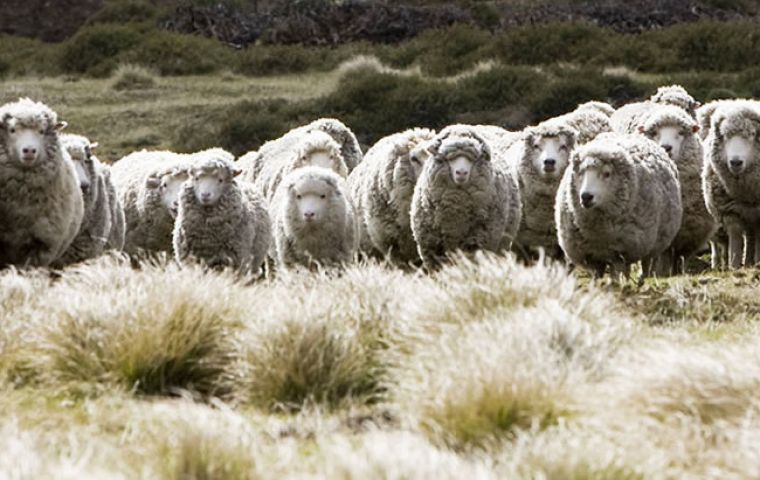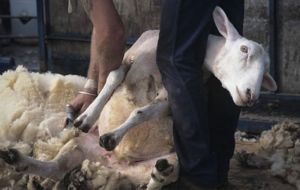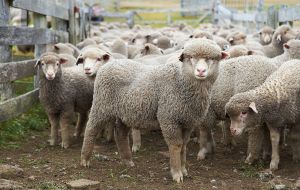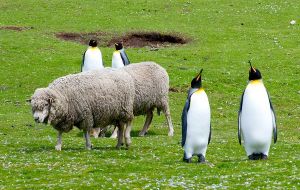MercoPress. South Atlantic News Agency
Falklands' flock reaches 490.113; West Falkland produces more wool per sheep than in the East
 West Falklands is producing more wool per sheep than their East Falklands counterpart, but the East is currently running more than twice the amount of cattle
West Falklands is producing more wool per sheep than their East Falklands counterpart, but the East is currently running more than twice the amount of cattle  The average fleece weight on the West is 3.99kgs with 14 of the 34 farms producing fleeces in excess of the average.
The average fleece weight on the West is 3.99kgs with 14 of the 34 farms producing fleeces in excess of the average.  The amount of lambs marked on the West took a healthy leap with 69.4% of the 60,252 ewes mated producing young, while the previous year it was just 55.3%
The amount of lambs marked on the West took a healthy leap with 69.4% of the 60,252 ewes mated producing young, while the previous year it was just 55.3%  The East had an equally prolific season with 70.3% of the 108,041 ewes reproducing successfully; a 9.3% increase on the previous year.
The East had an equally prolific season with 70.3% of the 108,041 ewes reproducing successfully; a 9.3% increase on the previous year. By Sharon Jaffray - The Falkland Islands flock reached 490.113 sheep of which 281.671 in East Falkland and 177.506 in the West plus 30.936 in the outer islands, according to the latest Farming Statistics 2016/2017, in accordance with the Agricultural Returns Ordinance. Likewise the number of cattle was 3.433.
The stats show that West Falklands is producing more wool per sheep than their East Falklands counterpart, but the East is currently running more than twice the amount of cattle with 2,009 animals in total. The average fleece weight on the West is 3.99kgs with 14 of the 34 farms producing fleeces in excess of the average.
The Marshes farm currently produce the heaviest fleeces with Lakelands owned by Robin and Pat Marsh weighing in at 5.36kg, but Philomel owned by Gavin and Deirdre Marsh is not far behind with 5.02kg. It should be noted that this is the greasy fleece weight and does not take into account the amount of vegetable matter or sand that may be in the wool.
On the East the overall average fleece weight is slightly lower at 3.76kg with just over half the 35 farms producing better. Brookfield owned by Trudi McPhee is the top producer with 5.29kgs and Corriedale owned by R M Goodwin & Son at 4.73kg. Perhaps more importantly from a sheep farming perspective is the kilos of wool produced per hectare (ha) and it is here that West farmers Roy and Jodie McGhie at Port North shine through at just over twice the average of 1.45kgs greasy at 2.94kgs per ha. The Peaks (including Golding Island) owned by Tony and Susan Hirtle are next in line with 2.76kg per ha.
On the East, the 301 ha Greenfield owned by Spurs Henry produced a massive 4.78kg per ha of 315 sheep and Brookfield was top of the larger farms with a more consistent 2.86 kg per ha.
Arguably due to the logistics involved in getting beef animals to the abattoir, West farms sent just 110 across the Sound while the East sent 341. This demonstrates a downward trend with the East supplying 441 and the West 185 in the previous year.
However cattle numbers on both sides are on the increase, indicating that this is a business area and alternative source of income to wool sales that farmers are actively exploring.
The amount of lambs marked on the West took a healthy leap with 69.4 percent of the 60,252 ewes mated producing young, while the previous year just 55.3% was recorded.
The East had an equally prolific season with 70.3% of the 108,041 ewes reproducing successfully; a 9.3% increase on the previous year.
While farming statistics can be heavily dependent on seasonal weather, this is a positive message bearing in mind that the Agriculture Department’s Farm Improvement Plan (FIP) focuses on decreasing mortality rates and increasing lambing percentages and fleece weights.
Fears that sheep numbers across the Islands would continue a downward spiral are somewhat allayed by the fact that sheep numbers overall have increased marginally on the West (from 174,207 to 177,506) and on the East from 278,473 to 281,671. An annual increase of 6,497 animals in total.
While the immediate reaction might be that the amount of sheep sent to the abattoir has been drastically reduced, this is not the case with the East sending 1,027 more than the previous year, balancing out the 1,201 less shipped across from the West.
Also on the increase is the pasture being sown for perennial pasture indicating that work is ongoing to further reduce mortality rates in young sheep, increase lambing and of course, finish beef and lamb to a high standard to reach the shop shelves. Add to all of this, the fact that the wool clip across East and West Falklands has increased by almost 25,000 kgs and the wool prices are reported to be the best they have been for 10 years and the statistics relate a positive story for one of the main industries in the Islands.
The story for the 11 outer islands is equally as positive with sheep numbers increasing from 26,972 to 30,936, although the total wool clip and kgs per ha remained fairly static. An impressive 3,150 sheep were shipped to the abattoir from the outer islands which stock a total of 30,936 sheep and 498 cattle over 88,061 ha and boast a total resident population of just 23.
Director of Natural Resources John Barton said that the somewhat similar increases in lambing percentages across East, West and Islands must largely be due to seasonal variation with better weather and quality and quantity of feed in the latter period. He added: “The challenge for the departmental business plan is to produce options which provide for sustained improvement in lambing percentages and young sheep survival.” (Penguin News)




Top Comments
Disclaimer & comment rules-

-

-

Read all comments“ ...in accordance with the Agricultural Returns Ordinance. ”
Sep 18th, 2017 - 01:29 pm +1As opposed to the Unreturned Argie Ordnance.
England doesn't have a malvina, Hepathetic. Perhaps someone in the UK could sell you a nice map, however, showing that the Falkland Islands are a British Overseas Territory. We could sell you the same map in, say, 25 years.
Sep 19th, 2017 - 03:12 pm +1Sheep stagger Argument hummmm
Sep 22nd, 2017 - 06:13 pm 0Commenting for this story is now closed.
If you have a Facebook account, become a fan and comment on our Facebook Page!